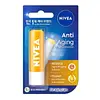What's inside
What's inside
 Key Ingredients
Key Ingredients

 Benefits
Benefits

 Concerns
Concerns

 Ingredients Side-by-side
Ingredients Side-by-side

Octyldodecanol
EmollientRicinus Communis Seed Oil
MaskingHydrogenated Rapeseed Oil
EmollientBeeswax
Emulsion StabilisingHomosalate
Skin ConditioningOctocrylene
UV AbsorberCetyl Palmitate
EmollientButyl Methoxydibenzoylmethane
UV AbsorberEthylhexyl Salicylate
UV AbsorberCetyl Ricinoleate
EmollientBis-Diglyceryl Polyacyladipate-2
EmollientCetearyl Alcohol
EmollientButyrospermum Parkii Butter
Skin ConditioningPersea Gratissima Oil
Skin ConditioningSimmondsia Chinensis Seed Oil
EmollientTocopheryl Acetate
AntioxidantBHT
AntioxidantParfum
MaskingCI 77891
Cosmetic ColorantCI 77492
Cosmetic ColorantOctyldodecanol, Ricinus Communis Seed Oil, Hydrogenated Rapeseed Oil, Beeswax, Homosalate, Octocrylene, Cetyl Palmitate, Butyl Methoxydibenzoylmethane, Ethylhexyl Salicylate, Cetyl Ricinoleate, Bis-Diglyceryl Polyacyladipate-2, Cetearyl Alcohol, Butyrospermum Parkii Butter, Persea Gratissima Oil, Simmondsia Chinensis Seed Oil, Tocopheryl Acetate, BHT, Parfum, CI 77891, CI 77492
Olea Europaea Fruit Oil
MaskingPetrolatum
EmollientParaffinum Liquidum
EmollientDiisostearyl Malate
EmollientCeresin
Emulsion StabilisingHydrogenated Coco-Glycerides
EmollientDipentaerythrityl Hexahydroxystearate
EmulsifyingCaprylic/Capric Triglyceride
MaskingEthylhexyl Methoxycinnamate
UV AbsorberCyclodextrin
AbsorbentPolyethylene
AbrasiveDimethicone
EmollientSqualane
EmollientTocopheryl Acetate
AntioxidantIsotridecyl Isononanoate
EmollientMicrocrystalline Wax
Emulsion StabilisingParfum
MaskingSilica
AbrasiveButyl Methoxydibenzoylmethane
UV AbsorberBHT
AntioxidantCI 15985
Cosmetic ColorantBlue 1 Lake
Cosmetic ColorantCI 45380
Cosmetic ColorantOlea Europaea Fruit Oil, Petrolatum, Paraffinum Liquidum, Diisostearyl Malate, Ceresin, Hydrogenated Coco-Glycerides, Dipentaerythrityl Hexahydroxystearate, Caprylic/Capric Triglyceride, Ethylhexyl Methoxycinnamate, Cyclodextrin, Polyethylene, Dimethicone, Squalane, Tocopheryl Acetate, Isotridecyl Isononanoate, Microcrystalline Wax, Parfum, Silica, Butyl Methoxydibenzoylmethane, BHT, CI 15985, Blue 1 Lake, CI 45380
 Reviews
Reviews

Ingredients Explained
These ingredients are found in both products.
Ingredients higher up in an ingredient list are typically present in a larger amount.
BHT is a synthetic antioxidant and preservative.
As an antioxidant, it helps your body fight off free-radicals. Free-radicals are molecules that may damage your skin cells.
As a preservative, it is used to stabilize products and prevent them from degrading. Specifically, BHT prevents degradation from oxidation.
The concerns related to BHT come from oral studies; this ingredient is currently allowed for use by both the FDA and EU.
However, it was recently restricted for use in the UK as of April 2024.
Learn more about BHTAlso known as Avobenzone, this ingredient is a chemical sunscreen filter that provides protection in the UV-A range.
Avobenzone is globally approved and is the most commonly used UV-A filter in the world.
Studies have found that avobenzone becomes ineffective when exposed to UV light (it is not photostable; meaning that it breaks down in sunlight). Because of this, formulations that include avobenzone will usually contain stabilizers such as octocrylene.
However, some modern formulations (looking at you, EU!) are able to stabilize avobenzone by coating the molecules.
Avobenzone does not protect against the UV-B range, so it's important to check that the sunscreen you're using contains other UV filters that do!
The highest concentration of avobenzone permitted is 3% in the US, and 5% in the EU.
Learn more about Butyl MethoxydibenzoylmethaneParfum is a catch-all term for an ingredient or more that is used to give a scent to products.
Also called "fragrance", this ingredient can be a blend of hundreds of chemicals or plant oils. This means every product with "fragrance" or "parfum" in the ingredients list is a different mixture.
For instance, Habanolide is a proprietary trade name for a specific aroma chemical. When used as a fragrance ingredient in cosmetics, most aroma chemicals fall under the broad labeling category of “FRAGRANCE” or “PARFUM” according to EU and US regulations.
The term 'parfum' or 'fragrance' is not regulated in many countries. In many cases, it is up to the brand to define this term.
For instance, many brands choose to label themselves as "fragrance-free" because they are not using synthetic fragrances. However, their products may still contain ingredients such as essential oils that are considered a fragrance by INCI standards.
One example is Calendula flower extract. Calendula is an essential oil that still imparts a scent or 'fragrance'.
Depending on the blend, the ingredients in the mixture can cause allergies and sensitivities on the skin. Some ingredients that are known EU allergens include linalool and citronellol.
Parfum can also be used to mask or cover an unpleasant scent.
The bottom line is: not all fragrances/parfum/ingredients are created equally. If you are worried about fragrances, we recommend taking a closer look at an ingredient. And of course, we always recommend speaking with a professional.
Learn more about ParfumTocopheryl Acetate is AKA Vitamin E. It is an antioxidant and protects your skin from free radicals. Free radicals damage the skin by breaking down collagen.
One study found using Tocopheryl Acetate with Vitamin C decreased the number of sunburned cells.
Tocopheryl Acetate is commonly found in both skincare and dietary supplements.
Learn more about Tocopheryl Acetate